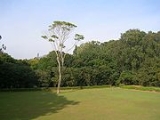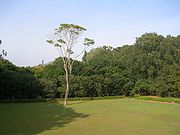
Raman Research Institute
Encyclopedia

Bangalore
Bengaluru , formerly called Bengaluru is the capital of the Indian state of Karnataka. Bangalore is nicknamed the Garden City and was once called a pensioner's paradise. Located on the Deccan Plateau in the south-eastern part of Karnataka, Bangalore is India's third most populous city and...
, India
India
India , officially the Republic of India , is a country in South Asia. It is the seventh-largest country by geographical area, the second-most populous country with over 1.2 billion people, and the most populous democracy in the world...
. It was started by Nobel
Nobel Prize
The Nobel Prizes are annual international awards bestowed by Scandinavian committees in recognition of cultural and scientific advances. The will of the Swedish chemist Alfred Nobel, the inventor of dynamite, established the prizes in 1895...
laureate Sir C. V. Raman
Chandrasekhara Venkata Raman
Sir Chandrasekhara Venkata Raman, FRS was an Indian physicist whose work was influential in the growth of science in the world. He was the recipient of the Nobel Prize for Physics in 1930 for the discovery that when light traverses a transparent material, some of the light that is deflected...
.
The main areas of research are:
- AstronomyAstronomyAstronomy is a natural science that deals with the study of celestial objects and phenomena that originate outside the atmosphere of Earth...
and AstrophysicsAstrophysicsAstrophysics is the branch of astronomy that deals with the physics of the universe, including the physical properties of celestial objects, as well as their interactions and behavior... - Liquid CrystalsLiquid crystalLiquid crystals are a state of matter that have properties between those of a conventional liquid and those of a solid crystal. For instance, an LC may flow like a liquid, but its molecules may be oriented in a crystal-like way. There are many different types of LC phases, which can be...
- Theoretical PhysicsTheoretical physicsTheoretical physics is a branch of physics which employs mathematical models and abstractions of physics to rationalize, explain and predict natural phenomena...
- OpticsOpticsOptics is the branch of physics which involves the behavior and properties of light, including its interactions with matter and the construction of instruments that use or detect it. Optics usually describes the behavior of visible, ultraviolet, and infrared light...
RRI has progressed from a research institution privately owned by a leading Indian scientist to a national centre in basic sciences in around half a century.
Founded by C.V. Raman, the only Nobel Prize
Nobel Prize
The Nobel Prizes are annual international awards bestowed by Scandinavian committees in recognition of cultural and scientific advances. The will of the Swedish chemist Alfred Nobel, the inventor of dynamite, established the prizes in 1895...
winner in science from India, in 1948, RRI is located in a sprawling campus very close to the Indian Institute of Science
Indian Institute of Science
Indian Institute of Science is a research institution of higher learning located in Bangalore, India. It was established in 1909.-History:After a chance meeting between Jamsetji N...
(IISc). The campus, lined with a large number of flowering and non-flowering trees planted by none other than Raman in the early years of the institution, even today is a secluded place of peace and tranquility as it was in Raman's days, despite being located in one of the busiest parts of Bangalore city.
Run on a grant received from the Department of Science and Technology (DST) since 1972, RRI has been carrying out research in several areas of fundamental science. These areas are theoretical physics, optics, liquid crystals and astronomy and astrophysics. Raman, during his days at the institute, refused to accept any funds from the Indian government and other sources as he believed that no funds could come without conditions.
"Raman who was an experimental scientist par excellence hated writing project reports and or for that matter giving periodic status reports to those who fund projects. He was of the firm belief that science could not be done that way," said Prof. N. V Madhusudana, Dean of Research at RRI and a leading liquid crystal scientist.
Raman had planned the institute much before he retired from IISc as the head of its Physics Department. As he had abhorred being idle even for a single day, his idea had been to walk straight into his newly-founded institute when he retired from IISc.
Much before he thought about founding an institute of his own, Raman had approached the then Maharaja of Mysore for land for building an office for the Indian Academy of sciences (IAS), which was again a brainchild of Raman. The Maharaja readily acceded to his request and a 10 acres (40,468.6 m²) plot was gifted to the academy in 1934. The decision to build a research institution on this land was subsequently taken when there was a danger of this piece of land being retrieved by the Government of Mysore as the academy failed to utilise it till the end of 1941.
Subsequently, Raman put forward a proposal to build a research institute to the academy at an extraordinary meeting and this was accepted by the meeting. Raman who raised the funds for the institute, was clear that it should have a distinct identity from the academy.
According to A Jayaraman, one of his students in the initial days of the institute, RRI was under the umbrella of the Indian Academy of Sciences. But Raman gradually changed this, for he thought conflicts could arise if the institute was not made into a statutory body. During his time, the presidency of the academy and the directorship of the institute rested in him. He was the supreme authority as far as the Institute was concerned. This highly personal style suited the temperament of the founder. Just before his death, however, Raman chartered out a framework for running the institute, giving it a separate status and autonomy. The Institute adopted the change in 1971 and stepped into a new era.
Prof. Madhusudana has said: "Till Raman's death, this was his private research institute. He had a very small group of research students working with him and a very few administrative staff. When he moved into the institute, the work on the building was incomplete and there was no electricity. This forced him to conduct several optics-related experiments using sunlight".
Despite its budgetary and infrastructural constraints, scientists working under Raman did some path-breaking work. For instance, S. Pancharatnam, who joined the institute in 1954, discovered a fundamental quantum optic effect, independent of Raman. This work, according to Jayaraman, was "the most outstanding original piece of research that came out of RRI at that time."
This discovery proved for the first time that geometric phase exists in optics. But this work was not known to the world till similar discovery was made by scientists elsewhere about two decades later. Subsequently, RRI could convincingly prove that Pancharatnam discovered this long ago and today "this phase is called Pancharatnam Phase world over," said Madhusudana. Pancharatnam unfortunately did not live long enough and his brilliant career was cut short when he died in 1969 while in Oxford.
The institute also houses Raman's prized collection of gems, crystals, minerals, and rock specimens from all over the world. Raman, who was fascinated by the colours of the biological kingdom, also had a veritable collection of stuffed birds, beetles, and butterflies in his museum. It is said that Raman used to take a lot of pride in showing off his precious collections to distinguished visitors to the institute. During Raman's time, many celebrated scientists from other countries paid a visit to the institute. Among them were: J. D. Bernal, E. C. Bullard, P. M. S. Blackett, C. G. Darwin, P. A. M. Dirac, G. Gamow, J. B. S. Haldane, Linus Pauling, C. F. Powell, L. Rosenfeld, G. Wentzel and Norbert Wiener.
One of the current research priority areas of the institute is liquid crystals. This has been an active area of research at the Raman Research Institute for nearly three decades. The research programme covers a broad spectrum of activities ranging from the synthesis of new liquid crystalline materials to display electronics. Discoveries of the columnar phase formed by disc-like molecules and pressure induced mesomorphism are two of the early significant contributions made by the liquid crystal group. "Out of 36 liquid crystal materials discovered world over three were from this institute," said Prof. Madhusudana. Among them are two new liquid crystalline phases, namely the undulating twist grain boundary C phase and the biaxial smectic A phase.
Techniques developed for driving passive matrix liquid crystal displays at the institute are now being widely used. In recent years the liquid crystal group has been working on electrochemical aspects of surface science and on other soft materials like surfactants, polymers, and on the physics of biological systems
Astronomy and astrophysics has been another strong area of research for RRI. According to Prof. Madhusudana, this division accounts for the maximum number of faculty and research students of the institute. Over the last 20 years, it has been carrying out observational programmes in radio astronomy, covering almost the entire radio spectrum. Besides having a millimetrewave telescope of 10.4 metre diameter on the campus, RRI has set up a decametrewave Radio telescope at Gauribidanur, about 80 kilometres away from Bangalore, jointly with the Indian Institute of Astrophysics (IIA), Bangalore. This is one of the few largest telescopes that operate at the wavelength of 10 metre and is being used by RRI scientists to study radio emission from various types of celestial objects such as the Sun, Jupiter and similar radio sources in Milky Way and other galaxies. Other radio telescopes that are being used by RRI scientists for observations are Ooty Radio Telescope, at Ooty, and Giant Metre wavelength Radio telescope (GMRT) , near Pune, both set up by the Tata Institute of Fundamental Research (TIFR). RRI also played an active role in building a low-frequency radio telescope in Mauritius jointly with the University of Mauritius and IIA.
The major astronomical investigations pursued at the Institute can be broadly classified into the following categories: (i) Neutron Stars and Pulsars; (ii) cosmology; (iii) Diffuse matter in space; and (iv) Radio Sky Surveys.
The theoretical physics activity in the institute has centred around relativity and gravity, quantum theory, and optics. The current activity in gravitation centres around two themes, gravitational radiation and quantum gravity. Gravitation is known to be the weakest of all known forces of nature, but it dominates all structure and motion on the astronomical scale because of its attractive universality, its long range and the fact that matter on the large scale is essentially neutral. The correct theory of gravitation is now believed to be Einstein
Albert Einstein
Albert Einstein was a German-born theoretical physicist who developed the theory of general relativity, effecting a revolution in physics. For this achievement, Einstein is often regarded as the father of modern physics and one of the most prolific intellects in human history...
's General Theory of Relativity. One of the fundamental predictions of General Theory of Relativity is that of gravitational waves — waves of distortion of spacetime itself - propagating at a finite speed of light. This replaces the Newtonian gravitations forces which was instantaneous. Such waves are expected to be emitted when, for example, two massive inspiralling stars tend to coalesce under their mutual gravitations attraction. Accurate calculation of this gravitational radiation — its waveform — has been one of the major research programmes of the theoretical physics group at the institute. Their work is expected to be a crucial input towards its eventual detection.
Another major activity of the theoretical physics group has been in studying propagation of light waves in certain types of liquid crystals and minerals and their associated polarization phenomenon. RRI has been a pioneer in this field of study which was actually initiated by one of Raman's research students, Pancharatnam.

